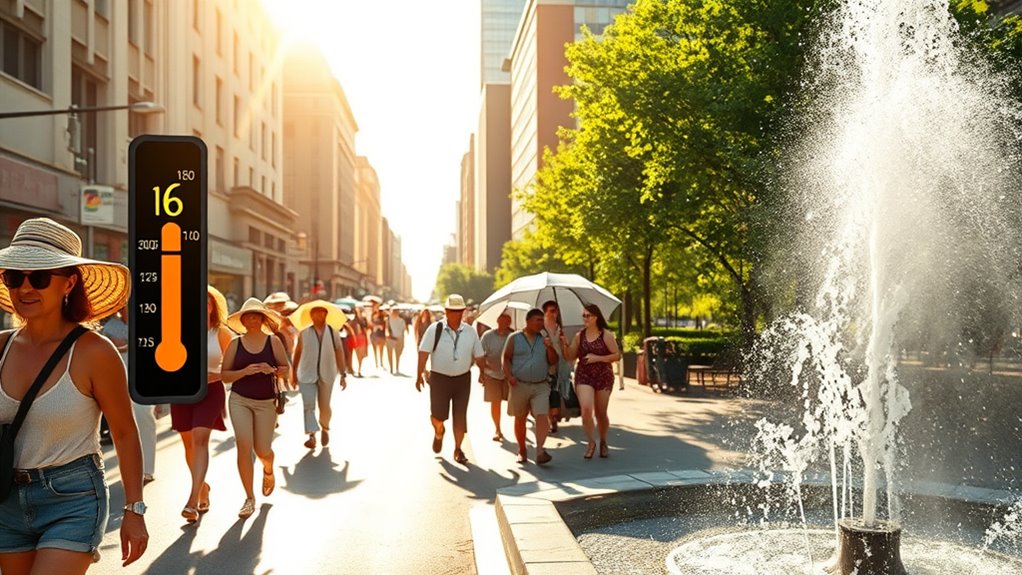The “feels like” temperature varies because both heat index and humidex consider humidity‘s effect on how hot it feels, but they do so slightly differently. When humidity is high, your body’s ability to cool down through sweating becomes less effective, making temperatures feel hotter than they actually are. Understanding these differences can help you better grasp how weather impacts comfort and safety. Keep exploring to see how these indices influence daily life and climate planning.
Key Takeaways
- Heat Index and Humidex both measure perceived temperature, but they use different calculation methods and factors.
- Humidex considers radiant temperature and is mainly used in Canada, while Heat Index focuses on air temperature and humidity.
- Variations in humidity, radiant heat, and local conditions cause “feels like” temperature to differ between the two indices.
- Changes in humidity or radiant heat levels can increase perceived temperature without altering actual air temperature.
- Understanding the differences helps in accurate public health advisories and effective heat stress mitigation.

When the weather feels hotter than the actual temperature, two commonly used measures—Heat Index and Humidex—help us understand how humidity impacts our comfort. These indices are essential tools for evaluating perceived temperature, especially during heatwaves or humid days. They reveal that the “feels like” temperature isn’t just about air temperature but also about humidity levels, which can make it feel notably hotter. Recognizing this is critical for climate adaptation, as communities need to plan for extreme heat conditions that threaten health and safety. Urban planning plays a key role here; designing cities with heat mitigation strategies, such as green spaces, shaded walkways, and reflective surfaces, can reduce the impact of high heat indices on residents.
The Heat Index combines air temperature and relative humidity to produce a single value that indicates how hot it really feels to the human body. When humidity is high, sweat doesn’t evaporate efficiently, impairing your body’s ability to cool down. This results in a higher perceived temperature, which can lead to heat exhaustion or heatstroke if precautions aren’t taken. Urban planners, aware of these effects, incorporate climate adaptation strategies into city designs. For example, increasing tree cover and implementing cool roofs help lower local heat indices, making outdoor environments more comfortable and reducing heat-related health risks.
Humidex, a measure primarily used in Canada, works similarly but also factors in other aspects like radiant temperature. It provides a more holistic picture of how humidity and heat combine to influence our perception of temperature. Recognizing the differences between Heat Index and Humidex helps authorities develop better public health advisories and prepare infrastructure that can withstand changing climate conditions. Effective urban planning, informed by these indices, ensures that cities remain resilient against heat stress. It guides decisions on creating more shaded areas, improving ventilation, and implementing policies that encourage climate adaptation practices.
Frequently Asked Questions
How Do Heat Index and Humidex Calculations Differ?
The heat index and humidex calculations differ in how they assess thermal perception. The heat index combines temperature and humidity to estimate how hot it feels, mainly used in the US. Humidex, used in Canada, also considers temperature and humidity but uses a different calculation method, emphasizing how humidity affects thermal perception. Both aim to give a more accurate “feels like” temperature, but their calculation methods vary slightly.
Which Index Is More Accurate for Humid Climates?
In humid climates, the humidex provides a more accurate measure of comfort levels because it considers both temperature and humidity’s impact on heat perception. You should rely on humidex to guide your clothing choices and assess how hot it feels, ensuring you stay comfortable and avoid heat-related issues. The humidex’s focus on moisture makes it better suited for humid environments, helping you make smarter decisions during hot, sticky days.
Can Heat Index and Humidex Predict Heat-Related Health Risks?
Yes, both heat index and humidex can help predict heat-related health risks. They reflect perceived discomfort and warn you when safety thresholds are near or exceeded. By understanding these indices, you can better judge when to take precautions, stay hydrated, or seek shade. Monitoring them allows you to prevent heat exhaustion or heat stroke, especially during extreme weather, ensuring your safety and well-being in hot, humid conditions.
How Do These Indices Affect Outdoor Activity Planning?
When planning outdoor activities, you should prioritize sports safety and clothing choices based on the heat index and humidex. These indices influence how hot it feels, guiding you to schedule activities during cooler times, wear lightweight clothing, and stay hydrated. By paying attention to these “feels like” measures, you reduce heat-related health risks, guarantee comfort, and maintain safety during outdoor pursuits. Always check these indices before heading out.
Are Heat Index and Humidex Used Internationally?
Yes, heat index and humidex are used internationally, especially in climate adaptation and urban planning efforts. You’ll see these indices guide decisions on public safety, infrastructure, and outdoor activities across different countries. They help you understand how humidity and temperature combine to affect comfort and health, prompting better urban designs and policies to cope with extreme weather conditions globally. This international use emphasizes their importance in managing climate-related challenges.
Conclusion
Understanding the heat index and humidex is like reading the weather’s secret language. They symbolize how your body perceives the sun’s hug or its icy grip, reminding you to listen to nature’s whispers. When the “feels like” shifts, it’s a signal to slow down, hydrate, or seek shade—your personal compass in the heat’s maze. Embrace these tools, and you’ll navigate summer’s challenges with confidence, as if you hold the key to the weather’s hidden story.









